Spatiotemporal Analysis of Human Mobility in Greater Tokyo Area Using Hourly 500 m Mobile Spatial Statistics from 2019 to 2021
Abstract
1. Introduction
- To elucidate weekday–weekend mobility patterns at the neighborhood scale within Tokyo from 2019 to 2021 using a daytime human mobility index derived from mobile phone statistics.
- To investigate the spatial relationship between the mobility patterns and public infrastructures.
- To investigate central–peripheral human mobility in Tokyo from the established human mobility index.
- To demonstrate and evaluate the spatiotemporal changes of human mobility and its patterns during the period surrounding the COVID-19 lockdown in Tokyo.
2. Methodology
2.1. Spatiotemporal Patterns of Human Mobility in Region
2.1.1. Daytime Human Mobility Index
2.1.2. DHMI*: Scaled DHMI
2.1.3. Classifying Mobility Patterns
2.2. Quantitative Infrastructure Spatial Analysis
2.2.1. Data Preprocessing
2.2.2. Quantitative Infrastructure Spatial Analysis
2.3. Central–Peripheral Comparative Analysis
2.3.1. Detection of Central–Peripheral Boundaries
2.3.2. Diurnal Mobility Profile
2.4. Datasets Used in This Study
2.4.1. DOCOMO Mobile Spatial Statistics
2.4.2. Infrastructure Data
3. Results and Discussions
3.1. Classification of Human Mobility Patterns
3.1.1. Daytime Human Mobility
3.1.2. Human Mobility Pattern
3.2. Quantitative Infrastructure Spatial Analysis
3.3. Central–Peripheral Comparative Analysis
3.3.1. Central–Peripheral Comparison
3.3.2. Diurnal Mobility Profile
4. Conclusions
Supplementary Materials
Author Contributions
Funding
Institutional Review Board Statement
Informed Consent Statement
Data Availability Statement
Acknowledgments
Conflicts of Interest
Abbreviations
| MSS | Mobile Spatial Statistics |
| Pop | hourly population |
| ResPop | residential population |
| DHMI | Daytime Human Mobility Index |
Appendix A
| Mobility Patterns | |||||
|---|---|---|---|---|---|
| Public | Inflow | Outflow | |||
| Infrastructure Types | Allweek | Weekday | Weekend High | Low | |
| Reference | 526 | 796 | 657 | 2955 | 394 |
| Police station | 33 | 62 | 16 | 73 | 14 |
| Municipal office | 34 | 27 | 12 | 10 | 7 |
| Child welfare facility | 45 | 99 | 55 | 484 | 83 |
| Elderly welfare facility | 87 | 91 | 73 | 370 | 58 |
| Fire department | 42 | 71 | 37 | 181 | 34 |
| Hospital | 119 | 122 | 68 | 277 | 53 |
| High school | 38 | 102 | 45 | 179 | 50 |
| Library | 51 | 49 | 46 | 166 | 47 |
| Post office | 207 | 228 | 144 | 784 | 142 |
| University | 18 | 124 | 25 | 14 | 21 |
References
- Hannah, R.; Samborska, V.; Roser, M. Urbanization. 2024. Available online: https://ourworldindata.org/urbanization (accessed on 16 June 2024).
- Lobo, J.; Aggarwal, R.M.; Alberti, M.; Allen-Dumas, M.; Bettencourt, L.M.; Boone, C.; Brelsford, C.; Broto, V.C.; Eakin, H.; Bagchi-Sen, S.; et al. Integration of Urban Science and Urban Climate Adaptation Research: Opportunities to Advance Climate Action. NPJ Urban Sustain. 2023, 3, 32. [Google Scholar] [CrossRef]
- Wang, A.; Zhang, A.; Chan, E.H.W.; Shi, W.; Zhou, X.; Liu, Z. A Review of Human Mobility Research Based on Big Data and Its Implication for Smart City Development. ISPRS Int. J. Geo-Inf. 2021, 10, 13. [Google Scholar] [CrossRef]
- Chen, Y.; Zhang, Z.; Lang, L.; Long, Z.; Wang, N.; Chen, X.; Wang, B.; Li, Y. Measuring the Spatial Match between Service Facilities and Population Distribution: Case of Lanzhou. Land 2023, 12, 1549. [Google Scholar] [CrossRef]
- Wang, R.; Zhang, X.; Li, N. Zooming into mobility to understand cities: A review of mobility-driven urban studies. Cities 2022, 130, 103939. [Google Scholar] [CrossRef]
- Bettencourt, L.M. The origins of scaling in cities. Science 2013, 340, 1438–1441. [Google Scholar] [CrossRef] [PubMed]
- Wang, D.; Pedreschi, D.; Song, C.; Giannotti, F.; Barabasi, A.L. Human mobility, social ties, and link prediction. In Proceedings of the 17th ACM SIGKDD International Conference on Knowledge Discovery and Data Mining, San Diego, CA, USA, 21–24 August 2011; KDD ’11. pp. 1100–1108. [Google Scholar] [CrossRef]
- Yabe, T.; Tsubouchi, K.; Fujiwara, N.; Wada, T.; Sekimoto, Y.; Ukkusuri, S.V. Non-compulsory measures sufficiently reduced human mobility in Tokyo during the COVID-19 epidemic. Sci. Rep. 2020, 10, 18053. [Google Scholar] [CrossRef] [PubMed]
- Xiaomeng, C.; Guozhen, L.; Yang, Y.; Qingquan, L. Estimating the Distribution of Economy Activity: A Case Study in Jiangsu Province (China) Using Large Scale Social Network Data. In Proceedings of the 2014 IEEE International Conference on Data Mining Workshop, Shenzhen, China, 14 December 2014; pp. 1126–1134. [Google Scholar] [CrossRef]
- Simini, F.; González, M.C.; Maritan, A.; Barabási, A.L. A universal model for mobility and migration patterns. Nature 2012, 484, 96–100. [Google Scholar] [CrossRef] [PubMed]
- Wang, P.; González, M.C.; Hidalgo, C.A.; Barabási, A.L. Understanding Road Usage Patterns in Urban Areas. Sci. Rep. 2012, 2, 1001. [Google Scholar] [CrossRef]
- Kraemer, M.U.G.; Golding, N.; Bisanzio, D.; Bhatt, S.; Pigott, D.M.; Ray, S.E.; Brady, O.J.; Brownstein, J.S.; Faria, N.R.; Cummings, D.A.T.; et al. Utilizing general human movement models to predict the spread of emerging infectious diseases in resource poor settings. Sci. Rep. 2019, 9, 5151. [Google Scholar] [CrossRef]
- Tizzoni, M.; Bajardi, P.; Decuyper, A.; Kon Kam King, G.; Schneider, C.M.; Blondel, V.; Smoreda, Z.; González, M.C.; Colizza, V. On the use of human mobility proxies for modeling epidemics. PLoS Comput. Biol. 2014, 10, e1003716. [Google Scholar] [CrossRef]
- Bengtsson, L.; Lu, X.; Thorson, A.; Garfield, R.; von Schreeb, J. Improved Response to Disasters and Outbreaks by Tracking Population Movements with Mobile Phone Network Data: A Post-Earthquake Geospatial Study in Haiti. PLOS Med. 2011, 8, e1001083. [Google Scholar] [CrossRef] [PubMed]
- Barbosa, H.; Barthelemy, M.; Ghoshal, G.; James, C.R.; Lenormand, M.; Louail, T.; Menezes, R.; Ramasco, J.J.; Simini, F.; Tomasini, M. Human mobility: Models and applications. Phys. Rep. 2018, 734, 1–74. [Google Scholar] [CrossRef]
- Brockmann, D.; Hufnagel, L.; Geisel, T. The scaling laws of human travel. Nature 2006, 439, 462–465. [Google Scholar] [CrossRef]
- Song, C.; Koren, T.; Wang, P.; Barabási, A.L. Modelling the scaling properties of human mobility. Nat. Phys. 2010, 6, 818–823. [Google Scholar] [CrossRef]
- Zipf, G.K. The P1 P2/D Hypothesis: On the Intercity Movement of Persons. Am. Sociol. Rev. 1946, 11, 677–686. [Google Scholar] [CrossRef]
- Schläpfer, M.; Dong, L.; O’Keeffe, K.; Santi, P.; Szell, M.; Salat, H.; Anklesaria, S.; Vazifeh, M.; Ratti, C.; West, G.B. The Universal Visitation Law of Human mobility. Nature 2021, 593, 522–527. [Google Scholar] [CrossRef]
- Chang, S.; Pierson, E.; Koh, P.W.; Gerardin, J.; Redbird, B.; Grusky, D.; Leskovec, J. Mobility network models of COVID-19 explain inequities and inform reopening. Nature 2021, 589, 82–87. [Google Scholar] [CrossRef]
- Guo, P.; Sun, Y.; Chen, Q.; Li, J.; Liu, Z. The Impact of Rainfall on Urban Human Mobility from Taxi GPS Data. Sustainability 2022, 14, 9355. [Google Scholar] [CrossRef]
- Schneider, C.M.; Belik, V.; Couronné, T.; Smoreda, Z.; González, M.C. Unraveling daily human mobility motifs. J. R. Soc. Interface 2013, 10, 20130246. [Google Scholar] [CrossRef]
- Sparks, K.; Moehl, J.; Weber, E.; Brelsford, C.; Rose, A. Shifting temporal dynamics of human mobility in the United States. J. Transp. Geogr. 2022, 99, 103295. [Google Scholar] [CrossRef]
- González, M.C.; Hidalgo, C.A.; Barabási, A.L. Understanding individual human mobility patterns. Nature 2008, 453, 779–782. [Google Scholar] [CrossRef] [PubMed]
- Pan, Y.; Darzi, A.; Kabiri, A.; Zhao, G.; Luo, W.; Xiong, C.; Zhang, L. Quantifying human mobility behaviour changes during the COVID-19 outbreak in the United States. Sci. Rep. 2020, 10, 20742. [Google Scholar] [CrossRef] [PubMed]
- Santana, C.; Botta, F.; Barbosa, H.; González, M.C.; Simini, F. COVID-19 is linked to changes in the time–space dimension of human mobility. Nat. Hum. Behav. 2023, 7, 1729–1739. [Google Scholar] [CrossRef]
- Sulis, P.; Manley, E. Exploring similarities and variations of human mobility patterns in the city of London. Int. Arch. Photogramm. Remote Sens. Spat. Inf. Sci. 2018, 42, 51–58. [Google Scholar] [CrossRef]
- Güller, C.; Varol, C. Unveiling the daily rhythm of urban space: Exploring the influence of built environment on spatiotemporal mobility patterns. Appl. Geogr. 2024, 170, 103366. [Google Scholar] [CrossRef]
- Dai, J.; Schmöcker, J.D.; Sun, W. Analyzing demand reduction and recovery of major rail stations in Japan during COVID-19 using mobile spatial statistics. Asian Transp. Stud. 2024, 10, 100120. [Google Scholar] [CrossRef]
- Santiago-Iglesias, E.; Romanillos, G.; Sun, W.; Schmöcker, J.D.; Moya-Gómez, B.; García-Palomares, J.C. Light in the darkness: Urban nightlife, analyzing the impact and recovery of COVID-19 using mobile phone data. Cities 2024, 153, 105276. [Google Scholar] [CrossRef]
- Statista. Largest Urban Agglomerations Worldwide in 2023, by Population. Available online: https://www.statista.com/statistics/912263/population-of-urban-agglomerations-worldwide/ (accessed on 3 February 2025).
- United Nations Department of Economic and Social Affairs. World Urbanization Prospects 2018: Highlights; UN: New York, NY, USA, 2019. [Google Scholar]
- Cao, Z.; Asakura, Y.; Tan, Z. Coordination between node, place, and ridership: Comparing three transit operators in Tokyo. Transp. Res. Part Transp. Environ. 2020, 87, 102518. [Google Scholar] [CrossRef]
- Tokyo Metropolitan Government. One day in Tokyo. Available online: https://www.tdh.metro.tokyo.lg.jp/english/faq/living/style.html (accessed on 3 February 2025).
- West, G. Scale: The Universal Laws of Life, Growth, and Death in Organisms, Cities, and Companies; Penguin Books: Westminster, MD, USA, 2018. [Google Scholar]
- Yong, N.; Ni, S.; Shen, S.; Chen, P.; Ji, X. Uncovering stable and occasional human mobility patterns: A case study of the Beijing subway. Phys. Stat. Mech. Its Appl. 2018, 492, 28–38. [Google Scholar] [CrossRef]
- Terada, M.; Nagata, T.; Kobayashi, M. Population estimation technology for mobile spatial statistics. NTT DOCOMO Tech. J. 2013, 14, 10–15. [Google Scholar]
- Mas, E.; Koshimura, S. Feasibility of anomalous event detection based on Mobile Spatial Statistics: A study of six cases in Japan. Int. J. Disaster Risk Reduct. 2024, 110, 104625. [Google Scholar] [CrossRef]
- Kubo, T.; Uryu, S.; Yamano, H.; Tsuge, T.; Yamakita, T.; Shirayama, Y. Mobile phone network data reveal nationwide economic value of coastal tourism under climate change. Tour. Manag. 2020, 77, 104010. [Google Scholar] [CrossRef]
- Akatsuka, H.; Toyoda, M. Analysis of the relationship between urban dynamics and prevalence of remote work based on population data generated from cellular networks. Sci. Rep. 2023, 13, 20139. [Google Scholar] [CrossRef] [PubMed]
- Mizuno, T.; Ohnishi, T.; Watanabe, T. Visualizing Social and Behavior Change due to the Outbreak of COVID-19 Using Mobile Phone Location Data. New Gener. Comput. 2021, 39, 453–468. [Google Scholar] [CrossRef] [PubMed]
- Arimura, M.; Ha, T.V.; Okumura, K.; Asada, T. Changes in urban mobility in Sapporo city, Japan due to the Covid-19 emergency declarations. Transp. Res. Interdiscip. Perspect. 2020, 7, 100212. [Google Scholar] [CrossRef]
- Yamaguchi, H.; Nakayama, S. Pattern analysis of Japanese long-distance travel change under the COVID-19 pandemic. Transp. Res. Part Policy Pract. 2023, 176, 103805. [Google Scholar] [CrossRef]
- Dantsuji, T.; Sugishita, K.; Fukuda, D. Understanding changes in travel patterns during the COVID-19 outbreak in the three major metropolitan areas of Japan. Transp. Res. Part A Policy Pract. 2023, 175, 103762. [Google Scholar] [CrossRef]
- Hara, Y.; Yamaguchi, H. Japanese travel behavior trends and change under COVID-19 state-of-emergency declaration: Nationwide observation by mobile phone location data. Transp. Res. Interdiscip. Perspect. 2021, 9, 100288. [Google Scholar] [CrossRef]
- Jin, X.; Han, J. K-Means Clustering. In Encyclopedia of Machine Learning; Springer US: Boston, MA, USA, 2010; pp. 563–564. [Google Scholar] [CrossRef]
- Tavenard, R.; Faouzi, J.; Vandewiele, G.; Divo, F.; Androz, G.; Holtz, C.; Payne, M.; Yurchak, R.; Rußwurm, M.; Kolar, K.; et al. Tslearn, A Machine Learning Toolkit for Time Series Data. J. Mach. Learn. Res. 2020, 21, 1–6. [Google Scholar]
- Cao, W.; Dong, L.; Cheng, Y.; Wu, L.; Guo, Q.; Liu, Y. Constructing multi-level urban clusters based on population distributions and interactions. Comput. Environ. Urban Syst. 2023, 99, 101897. [Google Scholar] [CrossRef]
- Gupta, L.; Molfese, D.; Tammana, R.; Simos, P. Nonlinear alignment and averaging for estimating the evoked potential. IEEE Trans. Biomed. Eng. 1996, 43, 348–356. [Google Scholar] [CrossRef] [PubMed]
- Jordahl, K.; den Bossche, J.V.; Fleischmann, M.; McBride, J.; Wasserman, J.; Badaracco, A.G.; Gerard, J.; Snow, A.D.; Tratner, J.; Perry, M.; et al. geopandas/geopandas: v0.10.2, 2021. Available online: https://zenodo.org/records/5573592 (accessed on 13 February 2025).
- McHugh, M.L. The chi-square test of Independence. Biochem. Medica 2013, 23, 143–149. [Google Scholar] [CrossRef] [PubMed]
- Pedregosa, F.; Varoquaux, G.; Gramfort, A.; Michel, V.; Thirion, B.; Grisel, O.; Blondel, M.; Prettenhofer, P.; Weiss, R.; Dubourg, V.; et al. Scikit-learn: Machine Learning in Python. J. Mach. Learn. Res. 2011, 12, 2825–2830. [Google Scholar]
- Statistics Bureau of Japan. About Regional Mesh Statistics. Available online: https://www.stat.go.jp/data/mesh/m_tuite.html (accessed on 3 February 2025).
- MLIT. National Land Numerical Information. National Land Numerical Information Download Site. Available online: https://nlftp.mlit.go.jp/ksj/index.html (accessed on 16 June 2024).
- Umezaki, M.; Ishimaru, H.; Ohtsuka, R. Daily time budgets of long-distance commuting workers in tokyo megalopolis. J. Biosoc. Sci. 1999, 31, 71–78. [Google Scholar] [CrossRef] [PubMed]
- Ishibashi, S.; Taniguchi, M. Workstyle change effects on physical activity and health consciousness in Japan: Results from COVID-19 lifestyle activity survey. Transp. Res. Interdiscip. Perspect. 2022, 15, 100657. [Google Scholar] [CrossRef]
- Sun, Y.; Luo, S. A Study on the Current Situation of Public Service Facilities’ Layout from the Perspective of 15-Minute Communities—Taking Chengdu of Sichuan Province as an Example. Land 2024, 13, 1110. [Google Scholar] [CrossRef]
- Jia, Y.; Zheng, Z.; Zhang, Q.; Li, M.; Liu, X. Associations of Spatial Aggregation between Neighborhood Facilities and the Population of Age Groups Based on Points-of-Interest Data. Sustainability 2020, 12, 1692. [Google Scholar] [CrossRef]
- Ha, T.V.; Asada, T.; Arimura, M. Changes in mobility amid the COVID-19 pandemic in Sapporo City, Japan: An investigation through the relationship between spatiotemporal population density and urban facilities. Transp. Res. Interdiscip. Perspect. 2023, 17, 100744. [Google Scholar] [CrossRef]
- MHLW. Open Data on COVID-19. Available online: https://www.mhlw.go.jp/stf/covid-19/open-data.html (accessed on 3 February 2025).
- Javad Koohsari, M.; Nakaya, T.; Shibata, A.; Ishii, K.; Oka, K. Working from Home After the COVID-19 Pandemic: Do Company Employees Sit More and Move Less? Sustainability 2021, 13, 939. [Google Scholar] [CrossRef]
- Kawaguchi, D.; Kitao, S.; Nose, M. The impact of COVID-19 on Japanese firms: Mobility and resilience via remote work. Int. Tax Public Financ. 2022, 29, 1419–1449. [Google Scholar] [CrossRef]
- Herder, E.; Siehndel, P. Daily and weekly patterns in human mobility. In Proceedings of the 20th Conference on User Modeling, Adaptation, and Personalization, Montreal, Canada, 16–20 July 2012; pp. 338–340. [Google Scholar]
- Batty, M.; Axhausen, K.W.; Giannotti, F.; Pozdnoukhov, A.; Bazzani, A.; Wachowicz, M.; Ouzounis, G.; Portugali, Y. Smart cities of the future. Eur. Phys. J. Spec. Top. 2012, 214, 481–518. [Google Scholar] [CrossRef]
- Yu, S.; Lei, K.L.; Li, D.; Kim, Y.J.; Nemoto, M.; Gatson, S.; Yokohari, M.; Brown, R. Plan integration for urban extreme heat: Evaluating the impacts of plans at multiple scales in Tokyo, Japan. Urban Clim. 2024, 55, 101888. [Google Scholar] [CrossRef]
- Varquez, A.C.G.; Kiyomoto, S.; Khanh, D.N.; Kanda, M. Global 1-km present and future hourly anthropogenic heat flux. Sci. Data 2021, 8, 64. [Google Scholar] [CrossRef] [PubMed]










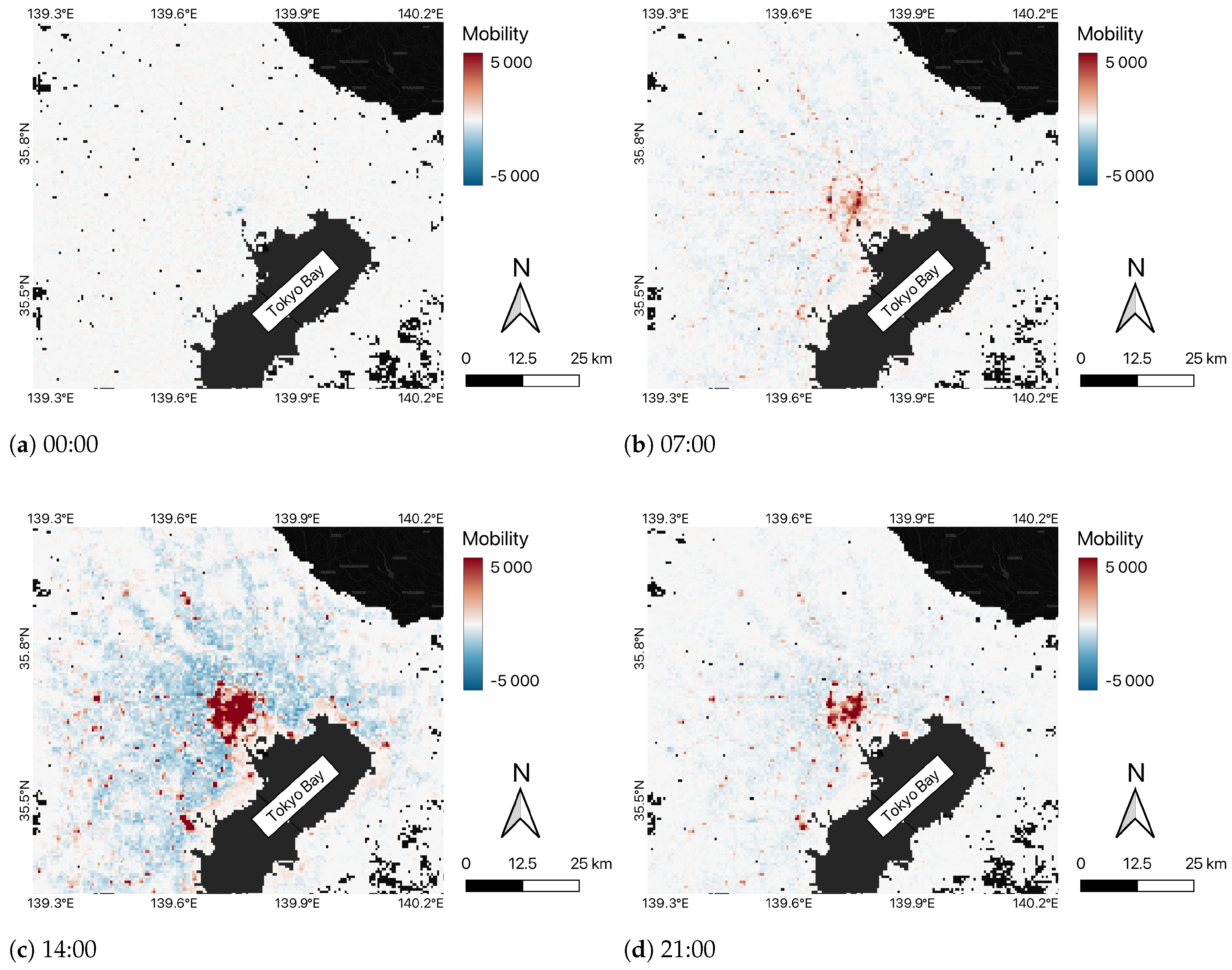
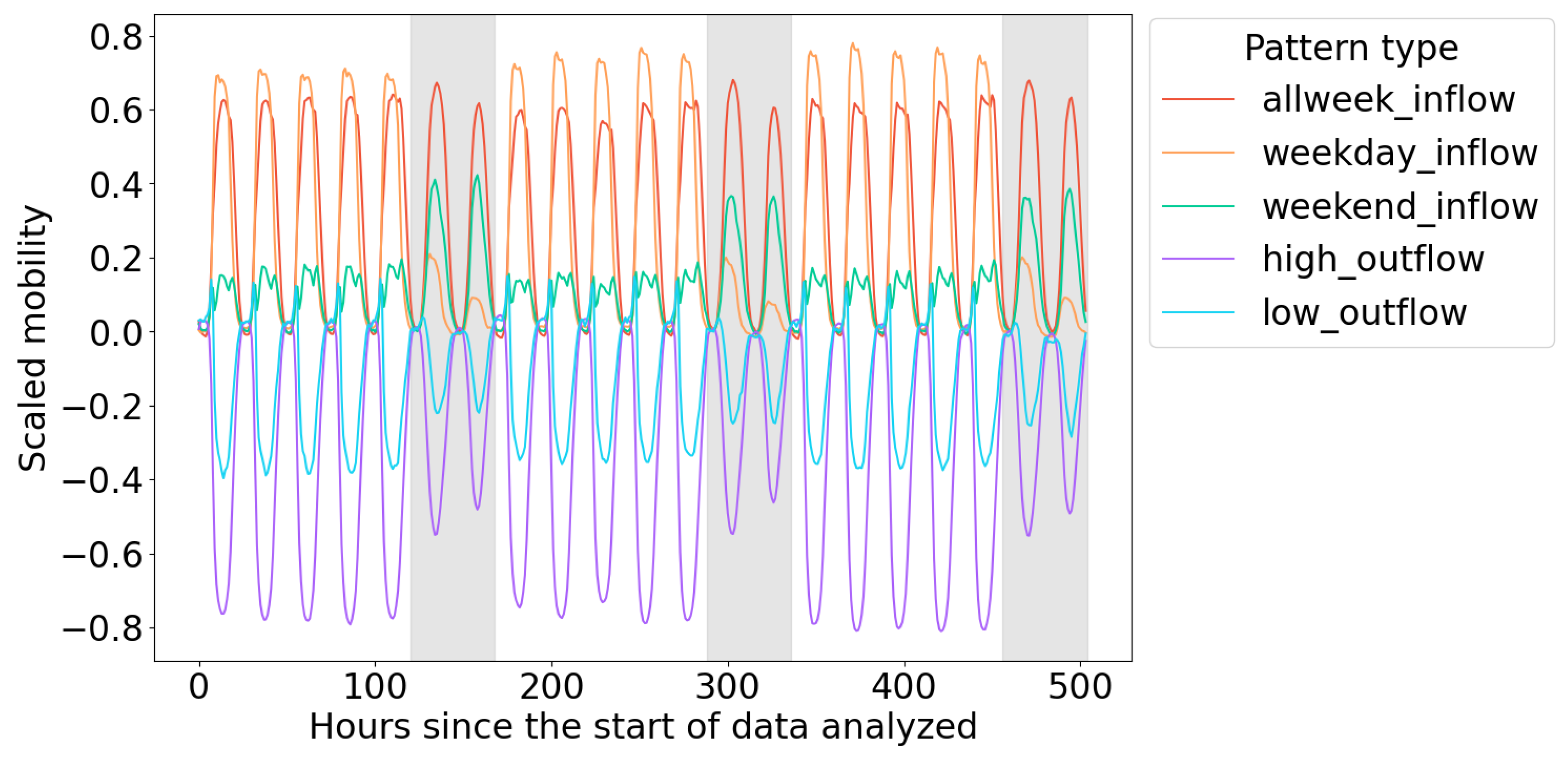

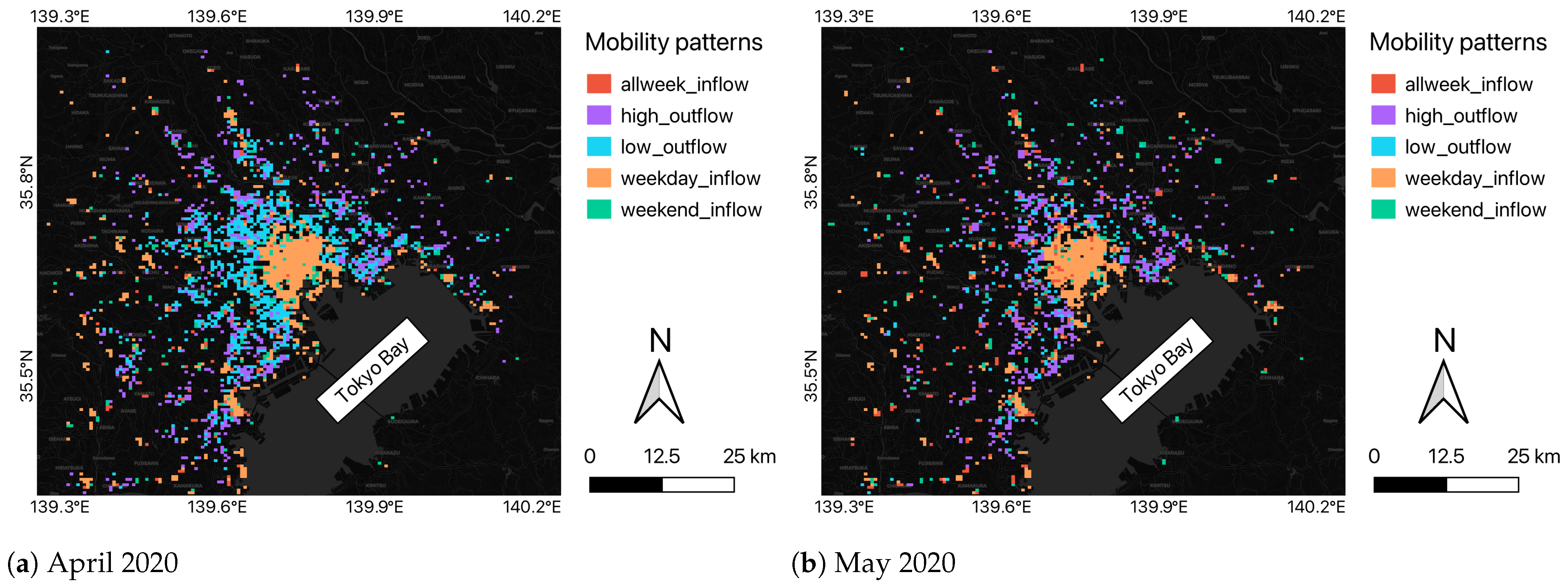

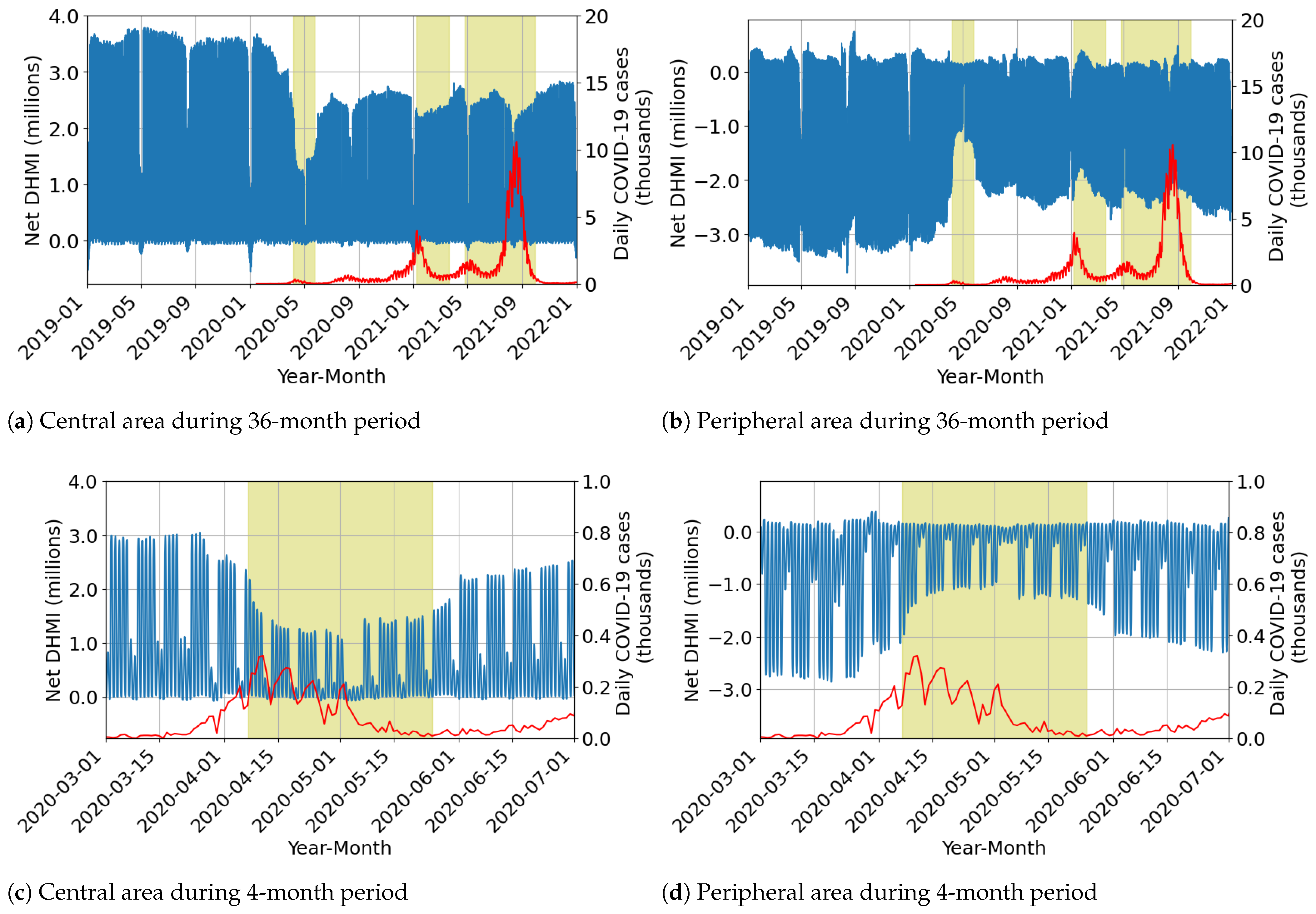


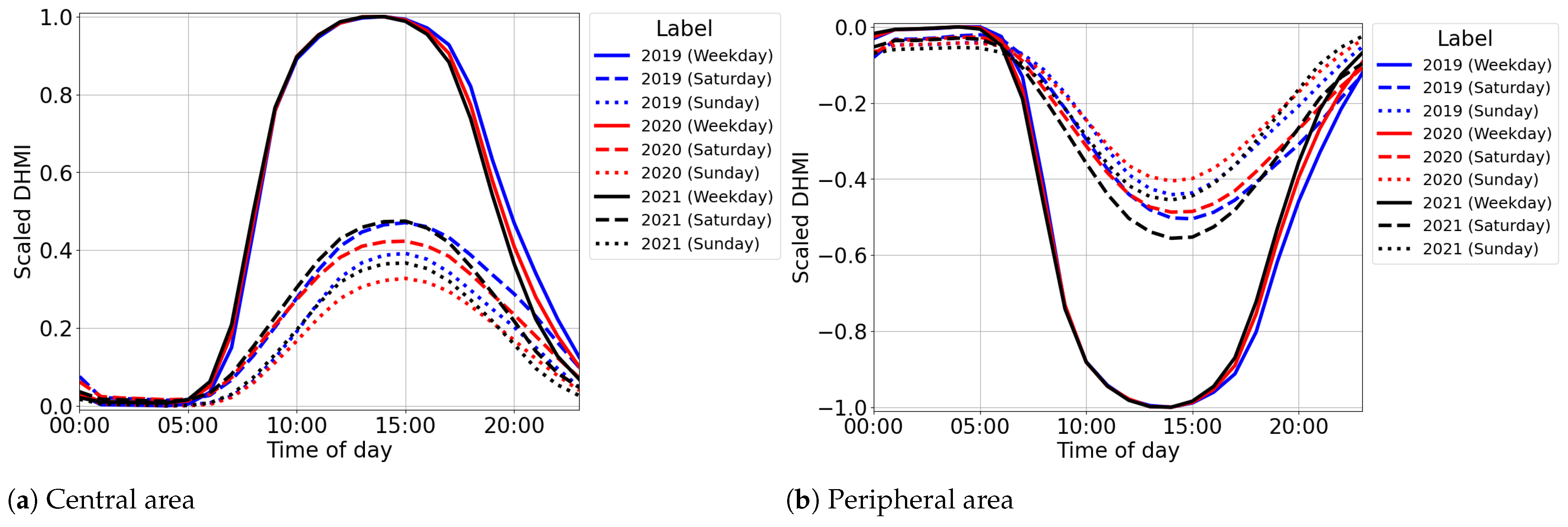
| Mobility Patterns | ||||||
|---|---|---|---|---|---|---|
| Public Infrastructure | Inflow | Outflow | ||||
| Types | All Week | Weekday | Weekend | High | Low | p -Value |
| Reference | 9.87% | 14.94% | 12.33% | 55.46% | 7.39% | - |
| Police station | 16.67% | 31.31% | 8.08% | 36.87% | 7.07% | |
| Municipal office | 37.78% | 30.00% | 13.33% | 11.11% | 7.78% | |
| Child welfare facility | 5.87% | 12.92% | 7.18% | 63.19% | 10.84% | |
| Elderly welfare facility | 12.81% | 13.40% | 10.75% | 54.49% | 8.54% | |
| Fire department | 11.51% | 19.45% | 10.14% | 49.59% | 9.32% | |
| Hospital | 37.78% | 30.00% | 13.33% | 11.11% | 7.78% | |
| High school | 9.18% | 24.64% | 10.87% | 43.24% | 12.08% | |
| Library | 14.21% | 13.65% | 12.81% | 46.24% | 13.09% | |
| Post office | 13.75% | 15.15% | 9.57% | 52.09% | 9.44% | |
| University | 8.91% | 61.39% | 12.38% | 6.93% | 10.40% | |
Disclaimer/Publisher’s Note: The statements, opinions and data contained in all publications are solely those of the individual author(s) and contributor(s) and not of MDPI and/or the editor(s). MDPI and/or the editor(s) disclaim responsibility for any injury to people or property resulting from any ideas, methods, instructions or products referred to in the content. |
© 2025 by the authors. Licensee MDPI, Basel, Switzerland. This article is an open access article distributed under the terms and conditions of the Creative Commons Attribution (CC BY) license (https://creativecommons.org/licenses/by/4.0/).
Share and Cite
Yoongsomporn, T.; Varquez, A.C.G.; Choi, S.; Okumura, M.; Hanaoka, S.; Kanda, M. Spatiotemporal Analysis of Human Mobility in Greater Tokyo Area Using Hourly 500 m Mobile Spatial Statistics from 2019 to 2021. Urban Sci. 2025, 9, 50. https://doi.org/10.3390/urbansci9020050
Yoongsomporn T, Varquez ACG, Choi S, Okumura M, Hanaoka S, Kanda M. Spatiotemporal Analysis of Human Mobility in Greater Tokyo Area Using Hourly 500 m Mobile Spatial Statistics from 2019 to 2021. Urban Science. 2025; 9(2):50. https://doi.org/10.3390/urbansci9020050
Chicago/Turabian StyleYoongsomporn, Thanakrit, Alvin Christopher Galang Varquez, Sunkyung Choi, Makoto Okumura, Shinya Hanaoka, and Manabu Kanda. 2025. "Spatiotemporal Analysis of Human Mobility in Greater Tokyo Area Using Hourly 500 m Mobile Spatial Statistics from 2019 to 2021" Urban Science 9, no. 2: 50. https://doi.org/10.3390/urbansci9020050
APA StyleYoongsomporn, T., Varquez, A. C. G., Choi, S., Okumura, M., Hanaoka, S., & Kanda, M. (2025). Spatiotemporal Analysis of Human Mobility in Greater Tokyo Area Using Hourly 500 m Mobile Spatial Statistics from 2019 to 2021. Urban Science, 9(2), 50. https://doi.org/10.3390/urbansci9020050








